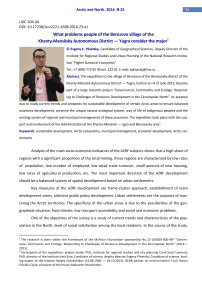What problems people of the Berezovo village of the Khanty-Mansiisky Autonomous District — Yugra consider the major
Автор: Evgeny E. Plisetsky
Журнал: Arctic and North @arctic-and-north
Рубрика: Economics, political science, society and culture
Статья в выпуске: 23, 2016 года.
Бесплатный доступ
The expedition to the village of Berezovo of the Berezovsky district of the Khanty-Mansiisk Autonomous District — Yugra, held on 6—8 of June 2015, became part of a large research project “Governan-ce, Community and Ecology: Responding to Challenges of Resource Development in the Circumpolar North”. Its purpose was to study current trends and prospects for sustainable development of certain Arctic areas to ensure balanced economic development, preserve the unique natural ecological system, way of life of indigenous peoples and the existing system of regional and municipal management of these processes. The expedition took place with the support and involvement of the Administration of the Khanty-Mansiisk — Ugra and Berezovsky area.
Sustainable development, Arctic ecosystems, municipal management, economic development, Arctic settlements
Короткий адрес: https://sciup.org/148318654
IDR: 148318654 | УДК: 304.44 | DOI: 10.17238/issn2221-2698.2016.23.41
Текст научной статьи What problems people of the Berezovo village of the Khanty-Mansiisky Autonomous District — Yugra consider the major
Analysis of the main socio-economic indicators of the AZRF subjects shows that a high share of regions with a significant proportion of the total mining, these regions are characterized by low rates of population, low number of employed, low retail trade turnover, small amount of new housing, low rates of agricultural production, etc. The most important direction of the AZRF development should be a balanced system of spatial development based on urban settlements.
Key measures of the AZRF development are frame-cluster approach, establishment of team development zones, selective public policy development. Urban settlements are the outposts of mastering the Arctic territories. The specificity of the urban areas is due to the peculiarities of the geographical situation, hard climate, low transport accessibility and social and economic problems.
One of the objectives of the survey is a study of current trends and characteristics of the population in the North, level of social satisfaction among the local residents. In the course of the study, it was necessary to understand how the measures taken by the authorities help to solve economic, social and environmental problems, how the changes are assessed by the local population.
During the expedition, we collected 13 questionnaires completed by the members of public sector (education, culture, social services, community service, and fire protection) and consumer market. National composition of respondents is characterized by a predominance of Russian population — 61%; 23% of respondents were Khanty, 8% — Mansi, 8% — Ukrainians. The sample is generally consistent with the structure of the national composition of the population. According to the data from the 14th of October 2010, the total population amounted to 7 939 people; Russians — 4 794 people (60%), and Khanty — 980 people (12%). All the residents interviewed said that they spoke only Russian. One man said that he could speak the local language, but he did it rare.
What problems are slowing down the development of local self-government? The majority of respondents (more than 15%) outline the following four problems, namely: low skilled workforce; low quality and availability of services, including social services; lack of infrastructure development;
the formation of the local budget.
-
■ низкий уровень квалификации трудовых ресурсов, управленческих кадров
4 4 4

-
■ снижение качества и уровня доступности услуг, в том числе социальных
-
■ недостаточное развитие инфраструктуры
формирование местного бюджета забюрократизированная система низкий уровень деловой активности и развития предпринимательства коррупционная составляющая
-
Figure 1. The share of answers about major problems that slow down the development of the local self-government, %
Thus, we see that the population is primarily worried about the status of the areas they closely interact in everyday life. Qualification of workers in the social sphere and public services directly determine the quality of life in a city, village, etc.; the quality of roads, communication systems determine the level of connectivity of remote territory with major economic centres. The quality of the budget affects the possibilities for immediate solutions to the most pressing issues within the competence of the local government.
Among the most effective ways to address these problems, they pointed out: administrative activities (clear powers and responsibilities of the various services, reducing the number of necessary approvals, training sessions and seminars for public-sector workers), sociological activities (the study of the current needs of the local population) and economic activities (favourable conditions for po- tential investors). When answering the question: How to solve these problems? — 54% of respondents said about the need to utilize the financial mechanisms, 46% — institutional mechanisms.
Currently, all respondents pointed out, the degree of public participation in addressing municipal issues is generally passive. This response suggests a relatively low level of self-organization of the local population, the weak development of public organizations. Residents prefer not to participate and do not exercise their citizenship in order to address the most pressing and urgent problems.
When answering the question about the demographic situation in the past decade , the majority of respondents (over 75%) showed its decline. Rosstat's data analysis showed that in 2010—2015, population decline had occurred: the population reduced from 7 939 people to 7 777. The settlement has negative migration gain that in 2014 amounted to 138%. Today in the village, according to its residents, there are certain problems with employment. Opinions on that differ slightly. Only 15% of respondents said they had not seen problems with employment. More than 85% of respondents said about low wages in the public sector and job cuts.
The main directions of improving municipal management identified better qualifications of labour; removal of corruption due to tightening responsibility; elected chief of the local administration that is local him or herself; more active development of strategic planning.
The prevailing type of relations between the authorities and business : more than 70% of respondents rated at 2-3 points on a 5-mark scale. Therefore, they indicated a rather difficult situation in the village (Fig.2). It is worth mentioning here as well as a weak awareness of implemented programmes and forms of interaction between the business community and the local administration. In 2011 administration of the Berezovsky district, Ugra Foundation, the “District business incubator”, Ugra Foundation of microfinance and Investment Development Assistance Fund of Khanty-Mansisky Autonomous District signed the joint agreement on business-trainings.
A question about the relationship between the local population (indigenous people) and business: 15% of respondents reported about violations of the traditional ladn use of indigenous peoples. People named illegal fishing and hunting.
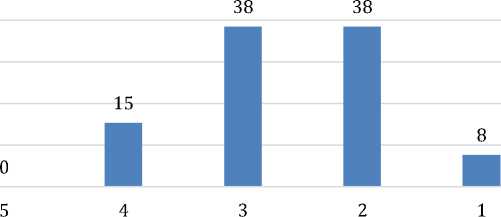
-
Figure 2. Share of responds about relationships between local authorities and business, %
Assessing the prevailing socio-economic development trends, the majority of respondents were more pessimistic. More than 70% of response data capture a certain slowing development of individual spheres of society. The largest proportion of pessimistic responses was given about the development of agriculture, social sphere and municipal management.
Финансово-банковские услуги
Строительство
Сельское хозяйство
Управление
Промышленность
Отрасли социальной сферы
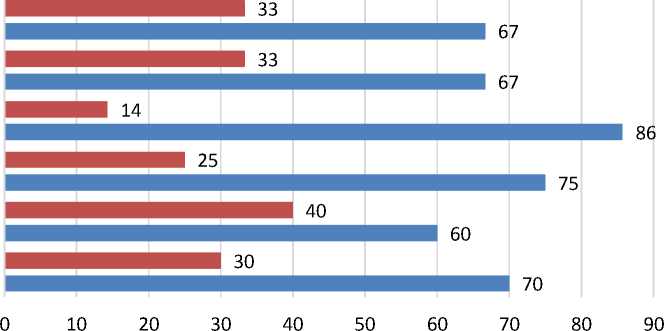
■ Ускоряется ■ Замедляется
Figure 3. Share of responces on socio-economic development, %
According to most respondents, there is a need for more specific policies aimed at revitalizing economic activity. At the same time, a priority for the next 2-3 years will be maintaining the current level of development and the maintenance to prevent the reduce of the social and economic level.
Are you connected to the Internet? The answer was given only by a half of all respondents. They confirmed its presence, and about 60% use the Internet frequently. At the same time, all respondents noted the extremely low speed of the Internet connection.
Responses to the question about existing problems in the development of public infrastructure in the municipality showed that problems exist in all proposed for responses industries, starting from the actual technical condition of the infrastructure, and ending up with the quality of service delivery.
One of the major problems of the socio-economic development at the settlement is poor accessibility of the territory. This is largely due to the high costs. The cost of the road construction, for example, in the Berezovsky district is 2 times higher than the cost of a road on the “big land. One kilometer of a road is two-three times more expensive than in Sverdlovsk oblast and the South of Ugra. Some years ago, various transport schemes to link Berezovo and the “mainland” had been done but got no further implementation3.
Among the housing problems, the respondents noted the poor quality of services, including those related to poor utilities. These conclusions have been confirmed by the official statistics, when the infrastructure replacement rates remain extremely low.
Table 1
Selected indicators of the development of municipal infrastructure and housing
|
Indicator |
Measurement |
2012 |
2013 |
2014 |
|
A single stretch of street gas network A single stretch of street gas network in need of replace- |
meter meter meter meter |
90 440 12000 |
90 440 12000 |
90 440 11 899 |
|
ment and repair The length of heat and steam networks in double-tube |
18 390 |
18 390 |
18 390 |
|
|
terms The length of heat and steam networks in double-tube terms, requiring replacement The length of heat and steam networks, which have been replaced or repaired during the reporting year |
||||
|
6 760 |
5 200 |
4 491 |
||
|
meter |
918 |
600 |
709 |
|
|
A single stretch of street mains |
meter |
16 541 |
13 460 |
13 400 |
|
A single stretch of street mains to be replaced |
meter |
6 400 |
2 200 |
1 750 |
|
A single stretch of street mains, which replaced and repaired during the reporting year |
meter |
603 |
600 |
460 |
|
A single stretch of street sewers |
meter |
3 500 |
3 500 |
3 500 |
|
A single stretch of street sewers in need of replacement |
meter |
500 |
1 600 |
1 600 |
|
The number living in dilapidated homes |
man |
1 136 |
793 |
793 |
|
The number living in unsafe homes |
man |
0 |
178 |
178 |
|
Relocated from dilapidated and emergency homes, people |
man |
150 |
44 |
44 |
Transport complex problems are related to the use of old equipment and technology and poor quality of roads. The building complex has problems with poor quality constructions and unfair work contractors. According to statistics, the rate of commissioning of new housing reduced significantly.

^^^^^™ Ввод в действие жилих домов на территории муниципального образования, квадратный метр общей площади
Figure 4. Building and housing construction sector
Consumer market development is hampered by recurrent food shortages due to poorly developed transport schemes and high food prices. At the same time, statistics say about the growth of the trade areas in 2012—2014: shops from 3 622 m2 to 4 438 m2; pavilions from 1 556 m2 to 2 210 m2, etc. In the field of environmental security, the problem of weak environmental controls and a lack of environmental organizations are particularly relevant. In case of telecommunications — poor communication and the Internet.
Social infrastructure development is constrained by the low level of health personnel; weak support from local and regional authorities of educational institutions; the low quality of health services, and reduction in the number of sports sections for adults; the lack of attention to the development of culture, leisure and tour activities. Culture is largely funded by the municipality and the districts (Department of culture of Khanty-Mansi Autonomous District — Yugra). They are funding the development of librarianship, additional educational programmes at art school, purchasing the musical instruments and literature. Distance is a challenge when attracting qualified personnel. Young people leave the village of Berezovo and move to Khanty-Mansiysk and other big cities. The main purpose of various cultural events is to raise attractiveness of the sttlement and to involve more people4.
Responding to a question about the need of ethnological and ecological expertise of the municipal projects, more than 70% of the respondents gave positive answer (Fig.5).

Да, полностью Да, частично Нет
Figure 5. Share of respondents who consider ethnological and ecological expertise necessary, %
Assessing the environmental changes for the past 5 years, more than 55% of respondents reported about environmental problems in the area (Fig. 6).
8 8
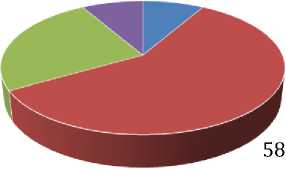
-
■ Улучшается ■ Ухудшается ■ Не заметил (не заметила) ■ Не меняется
-
Figure 6. Share of respondents assessed the state of the environment for the part 5 years, %
One of the negative factors affecting the environment is the lack of an efficient system for the MSW. The majority of respondents indicated that waste is stockpiled (partially buried) without sorting and reprocessing. Among the most pressing environmental challenges, respondents named surface water contamination and depletion of biological resources (problems got the lowest score). Their cause is common — lack of environmental management and environmental control. Ii is partly proved by statistics: in 2013—2014 removal of MSW reduced from 17.6 to 14.3 thousand m3 5. The least serious problems, according to residents of the village, are air pollution and inadequate ecological education of the population.
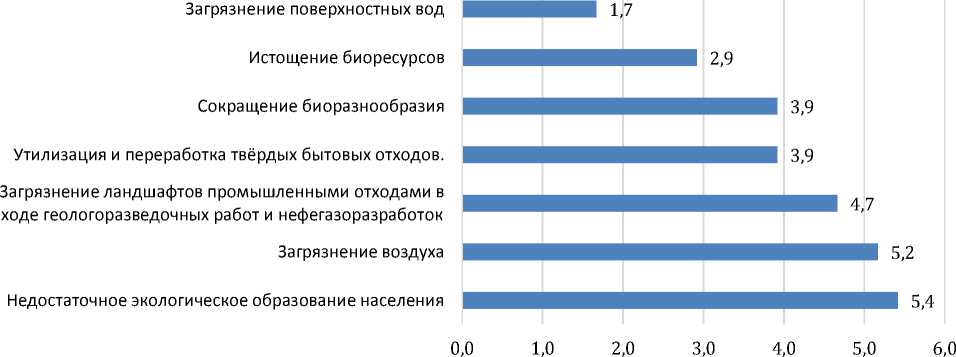
Figure 7. Most important ecological problems, overall assessment based on respondets’ answers (1—7 points, 1 — the most serious, 7 — the least serious)
The loss of biodiversity would have an effect on the quality of life of the local population. According to the survey, local products (fish, meat, berries) are 10—50% of the everyday diet.
The majority of respondents noted changes in climate, weather instability and warming that lead to the gradual decrease in the level of many rivers, the emergence of new, more southern species.
When answering the question about the regional programme for the development of ecological and ethnographic tourism, interviewees’ opinions divided. Some of them say that such a programm exists and its implementation is hampered by poor infrastructure caused by the harsh climate and poor transport accessibility of the territory. In addition, respondents noted the lack of interest of the authorities to this area. Although there is a weak awareness of the population on the existing priorities of the state, regional and municipal policy in the area,making tourism an important task of developing the economy of Khanty-Mansi Autonomous District.
Nevertheless, respondents noted the development of ethnographic and ecological tourism as a promising economic activity. In the course of the questioning, we had an interview with the Director of the tourist and ethnographic complex “Sorny Sei” Olga Konstantinovna Filippova. The tourist complex is located 10 km from the village Berezovo. Olga moved to Berezovsky district in the early 2000-ies from Baikal. She told us about the ides to build a tourist complex: “we were going to villages and observing rather bad social conditions; the area was remote, situated far from the civilization; not everyone can leave, sell piece of something and earn a bit <…> and I got idea to unite all of our local masters and to make traditional souvenir production. If someone knows how to do something, some crafts and can produce something, give us, and we show it at different exhibitions in Moscow and other cities, where these things are also sold”. Later, the handicraft camp was established for children (July 18, 2010). It hosts children during the holidays and in summer [3]. Workers at “Sorny Sei” are mainly the Khanty and Mansi people. Foreign tourists visit “Sorny Sei”. In addition, they organize training within the framework of the Russian-Canadian program NORDEP.
Respondents found it difficult to assess the level of international cooperation. With regard to the nature of the relationship between the visiting tourists and the local population, they spoke very positively.
Conclusion
Among the measures to improve the environmental situation in the area respondents proposed: to increase the level of ecological education; to construct waste recycling enterprises, to improve the operation of the landfill; to monitor the activities of oil companies; to held subbotniks; to reconstruc and upgrade the sewage treatment plants.
Key issues outlined by the survey are the following:
-
1. The principal obstacle to the development of the northern settlements is reducing the motivation of municipal authorities, the shortage of qualified and motivated personnel.
-
2. Limited accessibility affects business.
-
3. The problem of retention of the person in the set (existing) conditions.
-
4. To increase the value of public infrastructure, form the town environment and the image of urban settlement in the eyes of its residents and visitors.
-
5. Lack of principles and mechanisms of public finances management; to link the expenditure of budgetary funds with measurable social and meaningful results.
-
6. Provide funding for public infrastructure development, primarily through the regional budget.
-
7. Among the priorities is public infrastructure and its elements allocated to educational and medical institutions, reconstruction of municipal and transportation infrastructure.
-
8. Development of public infrastructure does not always have to focus on the alignment of the density and the quality of the basic infrastructures and increase access to social services (the validity of norms).
Список литературы What problems people of the Berezovo village of the Khanty-Mansiisky Autonomous District — Yugra consider the major
- Bolshanik P. V. Urovni antropogennoj nagruzki i ekologo-geograficheskoe rajonirovanie territorii XMAOYugry. Vestn. Tom. gos. un-ta. 2008. №317.
- Vaver O. Yu. Analiz resursnogo potenciala formirovaniya regionalnoj territorialnoj rekreacionnoj sistemy Xanty-Mansijskogo avtonomnogo okruga — Yugry. Vestnik NVGU. 2009. №4.
- Golubchikov S.N., Pliseckij E.E., Khetagurova V.Sh. Perspektivy razvitiya etnograficheskogo turizma v Arktike (na primere Beryozovskogo rajona Khanty-Mansijskogo avtonomnogo okruga). Sovremennye problemy servisa i turizma. 2015. T. 9. № 4. pp. 72—78.

